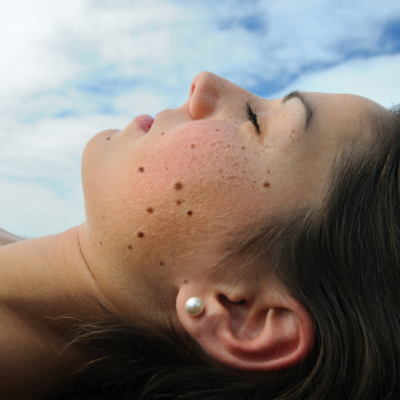Freckles and Age Spots – How to Zap Them Away and Keep Them at Bay
Freckles – those flecks of golden brown splashed across your face and chest – may have been with you since childhood. Maybe they were cute then but perhaps not now? Or maybe telltale splotches of brown have emerged as years of sun exposure take their toll. Either way, there’s no need to feel self-conscious and pile on loads of make-up to conceal them. Whether you adore your freckles or are simply curious for change, the choice is a medical or personal matter only – never one of conformity – and it is important for your health that you gain better understanding of these little brown spots. If you do seek a change, however, it is vital that you are aware of the proper methods and measures to take in removing them so as not to cause harm and damage to your skin and get the results you most desire.
As summer draws to a close, it’s the perfect time to take stock of any damage done by frolicking in the sun. Whether the summer sun has caused your freckles to proliferate or produced age spots, you can meet with a California Skin Institute dermatologist to strategize on how to banish those brown dots now. And how to keep them from returning.
Appearance aside, freckles and their 3-D cousins, moles can signal skin cancer, a serious condition your dermatologist will explore with you. If your freckles are determined to be benign, they can be removed by treatments including lasers, peels, or prescription topical creams or a combination depending on the kind of freckles you have and your skin type.
What Are Freckles and How Do They Get There?
The word freckle derives from the Middle English term freken, which itself comes from the Old Norse freknur. All three words mean the same thing; those brown spots.
Freckles usually occur in clusters across larger areas of the skin. Age spots tend to emerge by themselves or in proximity to one or two others. Both freckles and age spots are caused by skin pigmentation called melanin.
Melanin is the pigment that gives skin, hair and eyes color. Melanin is formed by specialized cells called melanocytes. Their job is to try to protect us from the sun’s harmful rays. Sun exposure activates them. People with darker skin tones have evolved to have more melanocytes which can result in a more uniform appearance known as a tan. Lighter-skinned people’s melanocytes respond to sun exposure with freckles. Some freckling however may be hereditary and appear regardless of sun exposure. And for nearly all types of skin, years of sun exposure will cause age spots, small, concentrated areas of increased melanin production.
The darker coloration of freckles and age spots depends on how many melanocytes cluster together, and how much melanin those clusters produce.
Freckles come in one of two types:
Ephelides, a Greek-derived medical term for the kind of freckles that develop during summer from sun exposure. These freckles tend to be light brown and usually disappear in winter. Sun protection, including sunscreen, can help prevent them. In 2004, scientists mapped the gene for these hereditary freckles to chromosome 4q32-q34. Be aware that people with this type of freckling may be more likely to develop skin cancer – an extra reason to be careful in the sun.
Lentigines, from the Latin word for lentil, are darker in color and permanent. Those that appear at the site of prior sun damage are called solar lentigo. Lentigines, especially those on the back of the hands, used to be called “liver spots.” But they have nothing to do with the liver. Lentigines are the ones removable by professional treatment.
Zapping Freckles with Lasers
Treatment with high-tech lasers is an effective way to minimize or eliminate freckles resulting in a smoother, clearer complexion. However, use of the wrong type of laser for your skin can have the opposite effect – exciting melanocytes and causing hyperpigmentation. That is why it is vital to seek experienced professional dermatologists like those at California Skin Institute.
The interaction of laser light with the skin creates a physiologic reaction causing targeted pigment to be broken down into smaller fragments absorbed by the body. We offer several types of lasers. These include the Q-Switched ND Yag laser which works by targeting specific pigment in the skin, the Q-Switched Alexandrite laser with a unique light wavelength significantly less likely to be absorbed by melanin and our new PicoSure which can achieve faster results faster and with less heat.
Other Types of Treatments
Based on a professional medically-based evaluation, your dermatologist may suggest other types of treatment for your freckles and/or age spots. Please note there are no home remedies or OTC products that remove freckles although the internet proclaims otherwise. Because of the high concentration of active ingredients required for effectiveness, the best products need to be prescribed and monitored by a licensed health professional.
Topically applied prescription products may include creams containing hydroquinone or retinoids, a highly concentrated form of vitamin A, such as Retin-A. Cryosurgery, essentially freezing an age spot or freckle by saturating it with liquid nitrogen, also may be an option. We also offer microdermabrasion, glycolic chemical peels and intense pulsed light therapy which can also help repair collagen.
Whatever treatment you and your dermatologist decide is best, maintaining the benefits of professional freckle and age spot removal will mean avoiding exposure to excessive sun, tanning beds and even self-tanning products. We think you’ll find the trade-off worth it.
Individual results may vary and are not guaranteed.



 / 291 Reviews
/ 291 Reviews